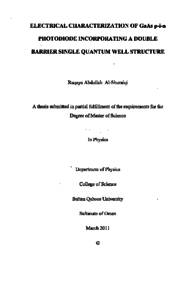Document
Electrical characterization of GaAs p-i-n photodiode incorporating a double barrier single quantum well structure
Publisher
Sultan Qaboos University
Gregorian
2011
Language
English
Subject
English abstract
GaAs p-i-n diode incorporating a double barrier single quantum well structure in the intrinsic region has been utilized in many fields of optoelectronic devices. It is found that dark current transport mechanisms are notably depending on both temperature and voltage. Thus in this study the dark (I-V) characteristics of DBQW p-i-n GaAs structure are investigated over a wide temperature range (20K-300K). The electrical parameters as the ideality factor (n), the saturation current (1,) and the series
resistance (R) are obtained from the dark forward (I-V) measurements. The values of R, which are extracted from Werner method increase as the temperature increases due to the effect of external connection. While analysis of the variation of n with temperature indicates that the dark current is dominated by the bulk recombination above 200K and by the tunneling enhanced recombination below 200K. The High values of n(n>2) are attributed to the existence of defects and localized trap states in the space charge region which assumed to distribute uniformly in (SCR). In the reverse bias regime where the saturation current strongly depends on the applied voltage, the dark current is limited by Poole-Frenkel emission at high temperatures. Whereas at low temperatures, the tunneling current controls the dark current of both regimes. In addition, below 120K the negative differential resistance (NDR) appears owing to the resonant tunneling of charge carriers through quasi-bound states of the QW which speculated to have significant influence on the dark current by their net charges.
Description
Thesis
Member of
Resource URL
Arabic abstract
نظرا لأهمية وصلة زرنيخيد الجاليوم المحتوية على تركيب البئر الكمي ذو الحاجز المزدوج في الطبقة غير المطعمة في العديد من الأجهزة الالكتروضوئية؛ فقد وجد أن أليات نقل التيار المعتم تعتمد بشكل أساسي على كل من الفولتية و درجة حرارة الوصلة، لذلك فإن هذه الدراسة تهدف للتحقق من الخصائص الكهربائية لوصلة ( DBQWp - i - nGaAs ) و ذلك بقياس شدة التيار الفولتية عند درجات حرارة تتراوح بين ( 20K - 300K ). وعند تحلیل منحنيات (7-1) للانحياز الموجب تم ايجاد العوامل المثالية (n) وتيار التشبع (1) و مقاومة السلسلة ( ,R) للوصلة عند كل درجة حرارة. و قد تم ايجادر ,R) باستخدام طريقة Werner و وجد أن هذه المقاومة تزداد بزيادة درجة الحرارة - بالرغم من قيمتها الصغيرة ( 1. 595) عند درجة حرارة الغرفة. ويعزى تكون هذه المقاومة للتوصيلات الخارجية في الدائرة الكهربائية. بينما اظهر تحليل تغير العامل المثالي مع درجات الحرارة أن آلية نقل التيار المعتم يتم التحكم فيه بواسطة آلية اعادة الارتباط في منطقة النضوب عند درجات الحرارة العالية ( T > 200K ) و يهيمن التيار النفقي المعزز بتيار اعادة الارتباط عند درجات الحرارة ( T < 200K ). أما قيم العامل المثالي المرتفعة ( 2 <n) فقد تم تفسيرها بافتراض وجود التشوهات و المصائد المتمركزة في منطقة النضوب وتوزعها بشكل منتظم. بالإضافة لذلك اظهرت النتائج أن تيار الانحياز السالب يتم تحديده بواسطة آلية انبعاث ( Poole - Frenkel ) عند درجات الحرارة العالية. في حين أن التيار النفقي يسيطر على آلية النقل في كل من منطقة الانحياز الموجب و السالب عند درجات الحرارة المنخفضة. أما عند ( T < 120K ) لوحظ تكون المقاومة السلبية التفاضلية (NDR) بسبب الرنين النفقي لحوامل الشحنات خلال مستويات الطاقة المكممة للبئر الكمي، و يدل هذا على تأثير البئر الكمي في محصلة التيار المعتم و خاصة عند درجات الحرارة المنخفضة نتيجة لزيادة سيطرة هذه الآلية بانخفاض درجات الحرارة.
Category
Theses and Dissertations

